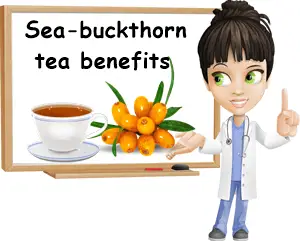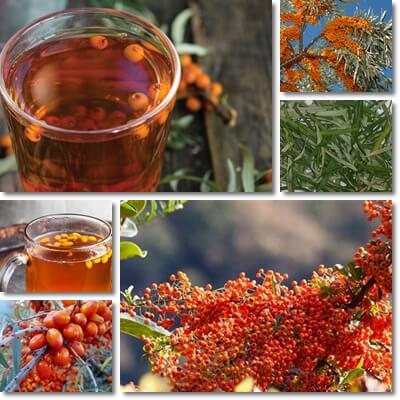Plenty of nutritionally valuable plants with wonderful therapeutic effects are generally too unpalatable to eat fresh, but nonetheless make an excellent tea. Steeping otherwise unpopular edibles such as sea-buckthorn in hot water helps extract many of their biologically active components along with their beneficial properties.
Sea-buckthorn tea is a great option for anyone not very into the berries themselves, or other edible parts of the plant. Whether you choose sea-buckthorn berry or leaf tea, know that you are choosing a healthy beverage that could provide a range of important benefits for both physical and mental health.
What is sea-buckthorn tea?
Sea-buckthorn tea is a herbal infusion made by steeping one or more edible parts of the sea-buckthorn plant into hot water. In some instances, the plant parts are boiled for a few minutes to help release as many biologically active components from the plant as possible. There are two major types of sea-buckthorn tea: berry tea and leaf tea.
However, mixes of the berry and leaf, and sometimes also flowers, are also available. In terms of health, sea-buckthorn tea is good for anxiety and stress, calms the nerves and aids sleep, but also soothes the stomach and can help lower high blood pressure numbers. Regular consumption can lead to other more meaningful health benefits over time.

What does sea-buckthorn tea look like?
Yellow sea-buckthorn berries will yield a beautiful pale to vivid yellow-colored tea, whereas orange sea-buckthorn berries will produce a paler orange to vivid orange-colored tea, sometimes with visible brown undertones. The color of your tea will depend on several other factors aside from berry pigment: how you make the tea, how concentrated it is and the kind of berries you use (fresh, whole or crushed, or dried).
On the other hand, sea-buckthorn leaf tea will be a clear and pale brown color with maybe an orangey undertone, depending on whether the leaves are fresh or dried. But if your sea-buckthorn tea is bright red or dark red, then it’s likely because it has other fruits added to it, most commonly rose hip or hawthorn berries or even hibiscus.
What does sea-buckthorn tea taste like?
The taste intensity and flavor profile of sea-buckthorn tea depends on the type of tea (fruit or leaf, or both), how it’s made (steeping, boiling or from juice) and how concentrated it is (leaf or fruit-to-water ratio). Sea-buckthorn berry tea should taste pleasant, tangy and maybe a little too sour, especially if it’s made from raw, fresh or frozen and thawed berries.
This type of sea-buckthorn tea can make your mouth pucker and dry (the astringency is owed to organic acids occurring naturally in the fruit that are also transferred to the tea during steeping or boiling, but in lesser amounts). However, the smell is particularly good, with pleasant, but modest tangy and sharp, fruity flavors. Sea-buckthorn leaf tea is less flavorful, with a typical green, leafy tea taste and herbal notes. Depending on concentration and steeping time, it may taste slightly bitter.
Uses for sea-buckthorn tea
- Therapeutic uses: You can drink the tea to combat dehydration by increasing fluid intake or just to keep hydrated, relieve stress and anxiety and induce calm and encourage sleep. Over time, regular consumption promotes diuresis which can help with instances of water retention and associated swelling (swollen ankles, swollen feet, swollen legs, swollen arms, puffy face or bloating) and contribute to lower blood pressure. Consumption of herbal teas also supports normal kidney function and even holds benefits for the prevention of urinary tract infections. Both the berry and leaf tea can potentially help lessen or calm stomach upset and relieve constipation.
- Cosmetic uses: You can apply cooled sea-buckthorn berry tea to the face to directly enjoy its antioxidant as well as tissue regenerative properties. Given that it contains organic acids and is astringent, the berry tea also has a skin tightening effect for a more youthful appearance.

How to make sea-buckthorn tea at home
- Method 1: Use raw berries, either freshly picked or frozen and thawed. Crush the berries with a fork, add a tablespoon or two of hot water and continue pressing to extract as much juice as possible. After that, add hot water and steep everything for 5-10 minutes. Strain the tea, sweeten to your liking (brown sugar, a favorite raw honey such as lavender honey or buckwheat honey, molasses) or flavor (e.g. cinnamon) and enjoy while still warm. For best results, choose the biggest, juiciest berries you can find, and make sure they’re ripe.
- Method 2: For a lighter-colored, less intense-tasting sea-buckthorn berry tea, use fresh, whole berries. Steep in hot water for 5-10 minutes and enjoy the resulting tea warm, flavored and sweetened to your liking.
- Method 3: Steep fresh or dried sea-buckthorn leaves in hot water for 5-10 minutes, then flavor and sweeten to your liking (e.g. you can lemon juice or lemon slices, orange juice or orange slices, brown sugar, raw honey).
- Method 4: Make the tea as you normally would, but instead of infusing the berries in hot water, boil on low heat for 5 minutes to lessen the astringency and encourage the berries to transfer more of their water-soluble biologically active components. At the same time, know that heat can damage nutritional compounds such as vitamin C.
- Method 5: For a fresher taste and more flavor, add a little sea-buckthorn juice to your tea.
Typically, the higher the leaf or berry-to-water ratio, the more flavorful the tea. Using fresh or frozen berries can color the tea water more vividly, while the use of dried berries can produce a deeper, darker color due to the pigments in the dried berries having oxidized.
What is sea-buckthorn tea good for?
Not all the bioactive components in sea-buckthorn fruit, or leaves, are also contained in the tea. And those that are, are not necessarily found in the same amounts as in the fruit or leaf. For the most part, water-soluble elements such as some antioxidants and vitamins and minerals leak into the tea water and provide it with therapeutic properties. But because not all teas are created equally, the nutritional and therapeutic properties may differ greatly.
- Antioxidant benefits. The bright-colored sea-buckthorn berry tea is rich in antioxidants, most notably carotenoids such as beta-carotene, but also lutein, zeaxanthin and lycopene. Antioxidants scavenge free radicals and combat oxidative stress, preventing cell damage that leads to inflammation and disease.
- Anti-aging properties. The berry tea can be used cosmetically and has a skin-tightening effect due to the presence of naturally-occurring organic acids with astringent properties (ascorbic, malic, tartaric, citric, oxalic and quinic acid), as well as exerts a local antioxidant effect. The pulp of the fruits is also a source of healthy fats which nourish the skin and contribute to its protective membrane, helping it retain moisture.
- Anti-inflammatory properties. Various biologically active components in the berry and leaf tea hold anti-inflammatory properties and promote tissue repair and hurry wound healing in instances of minor wounds such as small scratches or lesions.
- Benefits for digestive upset. Drinking sea-buckthorn tea can help soothe an upset stomach and possibly also help with symptoms of indigestion, bloating and abdominal cramps.
- Good for constipation. Upping your fluid intake can have a beneficial effect on constipation. Moreover, the tea is a source of bioactive components such as sterols and various polyphenols with beneficial effects on gastrointestinal transit.
- Supports normal kidney function. Drinking sea-buckthorn tea, both berry and leaf, supports normal kidney function and kidney health.
- Diuretic properties. Sea-buckthorn tea is a diuretic and helps with swelling of legs, arms, abdomen and face puffiness caused by water retention.
- Anti-hypertensive benefits. Drinking sea-buckthorn tea exerts a diuretic action which helps flush out excess sodium, with benefits for high blood pressure. There are also anti-hypertensive micronutrients such as potassium and magnesium present in trace amounts in the berry tea and modestly contribute to its blood pressure-lowering effects.
- Potential benefits for insomnia. The warm tea filled with antioxidant compounds and other beneficial bioactive components can induce mental and physical relaxation, reduce stress and promote restful sleep.
- Potential benefits for anxiety. Drinking tea has always had some benefits for anxiety and sea-buckthorn is a great option to consider since it’s filled with antioxidants and other beneficial components in addition to its soothing, calming properties.
What are the side effects of Sea-Buckthorn Tea?
Sea-buckthorn tea is safe for consumption, with the exception of instances of allergic reactions. If you know or suspect you are allergic to the plant, avoid consuming it in any form or preparation. It is also possible for the berry and leaf tea to interact with medication, such as hypertension medication, and potentiate their effects. Talk to your doctor before resorting to sea-buckthorn tea for therapeutic use.
